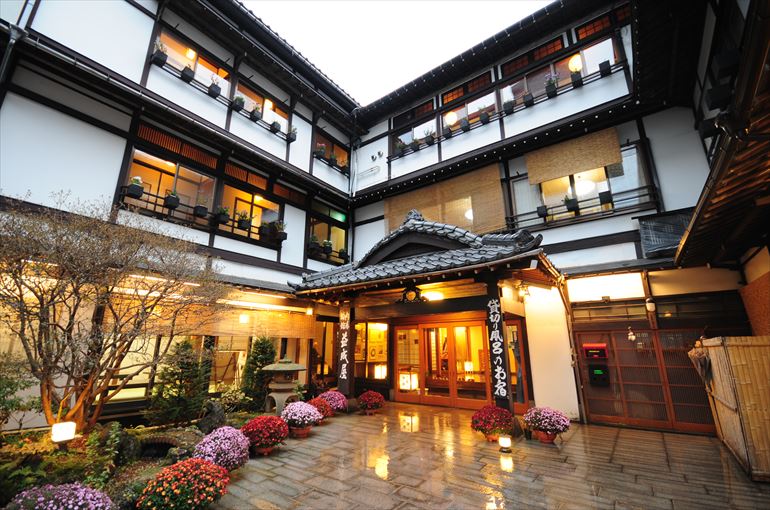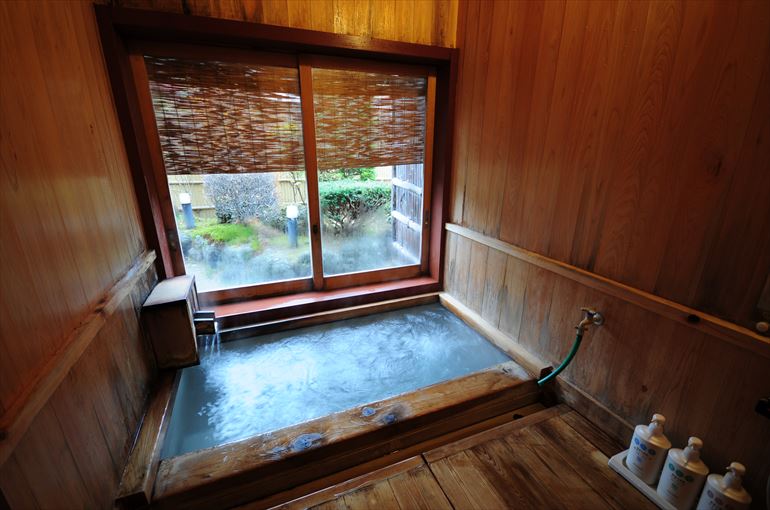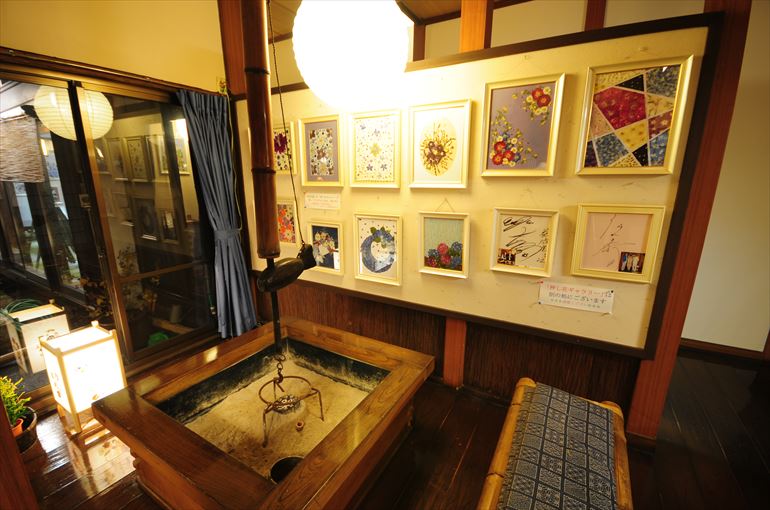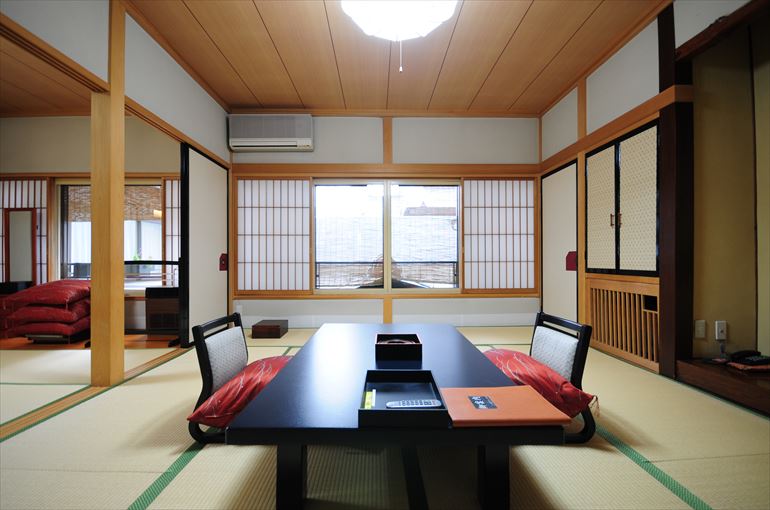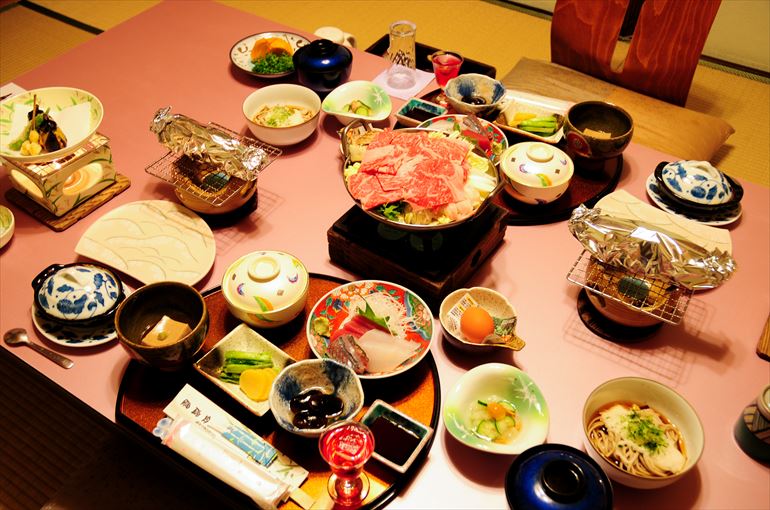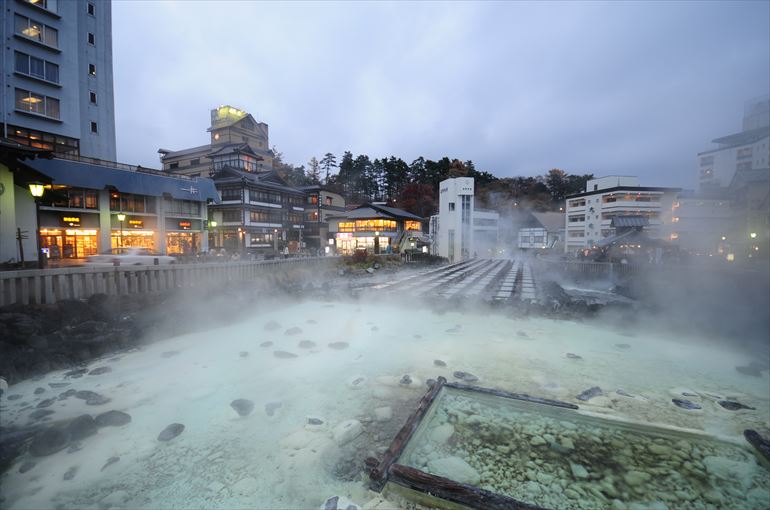EKINARIYA RYOKAN -Facilities & Hot Spring Reports (1)-
| Kusatsu Onsen, located in the northwestern part of Gunma Prefecture, Jyoshu, is a well-known hot spring in Japan. It has 6 main sources, including “Jizou”, “Yubatake”, “Shirahata”, “Sainokawara”, “Bandaikou”, and “Wata-no-Yu”, with a combined output of 36,000 liters per minute, one of the largest amounts of hot spring water in Japan. In addition, Kusatsu's hot spring is not a motor-driven spring or a pumped spring, but a naturally gushing spring, which is considered the ideal form of hot spring, and if compared to other naturally gushing springs, Kusatsu's hot water is the largest in Japan. The history of “Kusatsu Onsen” is ancient, and some say that the hot spring was discovered during the Kofun period (1336-1333) by the Japanese warrior Yamato Takeru on his way back from an eastern expedition, or that it was opened by Gyoki in the Nara period (710-794). Or, in the Kamakura Period in 1193, Minamoto no Yoritomo discovered the hot spring during a Maki-hunting at Mt. Asama as legend has it, it has been a well-known therapeutic hot spring for a long time. In 1472, during the Muromachi period (1392-1573), the Buddhist priest Rennyo took a bath here. There is also a record that the poet Sogi took a bath here in 1491. Entering the Azuchi-Momoyama period (1587), Princess Asahi-hime, the younger sister of Toyotomi Hideyoshi, also bathed here. In 1596, there is a historical record that Hideyoshi recommended a hot-spring cure in Kusatsu to Tokugawa Ieyasu, who was recovering from an illness. As a result, Ieyasu had Kusatsu's hot water brought to Edo Castle. In 1598, Maeda Toshiie, a feudal lord (daimyo) of Kaga Hyakumangoku, also bathed in Kusatsu. During the early Edo period (1603-1867), the area was under the direct government control of the Shogunate as the Numata domain of the Sanada clan, and later as the Tenryo domain. Despite the inconvenience of transportation compared to today, the area is said to have been crowded with more than 10,000 hot-spring cure visitors per year. Hayashi Razan, a prominent Confucian scholar in the early Edo period, praised “Arima”, “Gero”, and “Kusatsu” as the three most famous springs in Japan. Throughout the modern period, there were 60 inns in Kusatsu, and by the Edo period (1603-1867), Kusatsu had flourished to the extent that it was known as “Kusatsu Senken Edo-gamae” (1,000 houses in Kusatsu). At the beginning of the 18th century, the custom of private baths called “Kakoi-yu” and “Makuyu” was established, and later uchiyu (indoor baths) were provided. In 1717, the 8th shogun, Tokugawa Yoshimune, had Kusatsu's hot spring brought to Edo Castle, just as Ieyasu did. A record of this is preserved on a stone monument at the Yubatake, inscribed with the words as “Okumiage-no-yu”. In 1808, the haiku poet Kobayashi Issa also bathed in Kusatsu. Entering the Meiji Era (1868-1912), the German physician Dr. Erwin Bälz visited Kusatsu for the first time in 1878, and later introduced Kusatsu Onsen to the world. In 1918, the poet Hirai Banshun visited Kusatsu Onsen. And wrote a travelogue entitled “Yukemuri”. He also left behind two songs that are said to be the basis of the Kusatsu-bushi (traditional folk song). The songs include “Kusatsu yoitoko shirane no yuki ni atsusa shirazu no kazega huku” (“Kusatsu is a wonderful place, where the wind blows cool from the snow of Shirane, untouched by heat”) and “Kusatsu yoitoko sato e no sodemiyage ni yuhana no ko ga nokoru (“Kusatsu is a wonderful place, where the scent of hot spring minerals lingers on one’s sleeves as a souvenir for home”). In 1922, the writer Naoya Shiga visited Kusatsu. In 1929, poets Kihachi Ozaki, Kotaro Takamura, and Yumeji Takehisa bathed here. In 1933, the poet Mokichi Saito also bathed here. Kusatsu Onsen is symbolized by the “Yubatake” (hot spring fields). Here, 4,000 liters of hot water per minute overflows. It is also the center of the hot spring area. Ekinariya Ryokan is located just a short walk from Yubatake. The exterior of the ryokan, which exudes an Edo-style atmosphere, speaks to the character of Ekinariya Ryokan. The three-story wooden structure is full of elements that touch the heartstrings of Japanese people. |
EKINARIYA RYOKAN Travel Journal
Articles
The original founding of Ekinariya Ryokan dates back to the late Edo period, making it a long-established inn with a history of 140 years. At that time, Kusatsu Onsen’s Yubatake area, extending to where Ekinariya now stands, was within the domain of the local magistrate’s estate. After World War II, the ryokan was initially opened as a ryotei (Japanese-style restaurant). In 1969, the current owner’s predecessor officially registered Ekinariya as an inn, marking the beginning of its new chapter as a ryokan. The current building is unchanged from 1969,......
Private & Open-air Bath Reports
Each room at Ekinariya comes with its own private bath. Upon check-in, guests receive the key to their private bath along with their room key. In other words, for every 6 guest rooms......
Facilities & Hot Spring Reports
Kusatsu Onsen, located in the northwestern part of Gunma Prefecture, Jyoshu, is a well-known hot spring in Japan. It has 6 main sources, including “Jizou”, “Yubatake”, “Shirahata”, “Sainokawara”, “Bandaikou”, and “Wata-no-Yu”......
Guest Room Reports
There are a total of 6 guest rooms, all in traditional Japanese style. Each room has a slightly different layout. In wooden buildings, sound can sometimes travel between rooms, but at this inn, there is no need to worry about that......
Cuisine Reports
At Ekinariya, meals are generally served in private dining rooms located near the guest rooms. However, since there are only 5 dining rooms for 6 guest rooms,......
Extra Reports
Located in the heart of the hot spring area, “Yubatake” is a symbol of Kusatsu Onsen. It is a hot spring source that flows in the town center, surrounded by a well-maintained rotary. By the way,......
| Keywords for this ryokan | |||
|---|---|---|---|
| 6 guest rooms and 6 private baths | |||
| All bathtubs are 100% free-flowing hot spring water | |||
| Large public bath “Benten-no-Yu” filled with the aroma of hinoki cypress | |||
| A private and secluded inn for adults | |||
| The owner-chef's exquisite cuisine made with carefully selected local ingredients |
| Check-In | 2:00 p.m. | ||
|---|---|---|---|
| Check-Out | 10:00 a.m. | ||
| Card usage | Available | ||
| Room Views | Mountains, Townscape | ||
| In-room Meal | Not available (private dining room) | ||
| Dinner | Japanese cuisine | ||
| Breakfast | Japanese cuisine | ||
| Official website's online reservation benefits | 【Best Rate (Lowest Price) Guarantee】The most economical rates are available for reservations through official website. | ||
|---|---|---|---|
| Special Packages | For details of special offers such as official website limited plans and limited time plans, etc., please check the Official Website★ | ||
| Plan A guest room (Capacity of 2 persons) |
From 24,350 yen Up Charge for the day before holiday 2,200 yen ※Layout is 10 tatami mats Japanese-style room + Veranda + T + Private bath with free-flowing hot spring water |
||
| Plan B guest room (Capacity of 2 to 4 persons) |
From 26,550 yen Up Charge for the day before holiday 2,200 yen ※Layout is 12 tatami mats or more Japanese-style room + Private bath with free-flowing hot spring water |
||
| Establishment / Reconstruction | Established: 1969 / Reconstructed: 2008 | ||
|---|---|---|---|
| Number of Rooms | All 6 rooms | ||
| Number of People Accommodated | 16 persons | ||
| Private bath | Charge : Free of charge for overnight stay Usage hours : 2:00 p.m. to 9:30 a.m. the next day Reservation method : Each room is given a key to 1 private bath (you can occupy the private bath). View : Garden |
||
| Large public bath and other | Public open-air baths for men and women: None Large public “hinoki” baths for men and women: Available (※Switching between men and women: not available) |
||
| Parking Area | 6 cars | ||
| Pets | Not allowed | ||
| Barrier Free | Not supported | ||
| Esthetics / Massages | Massages: Yes(4,000 yen/40 min. tax not included) | ||
| Internet | Wi-Fi available | ||
| DVD | - | ||
| TV Channels | NHK: 2 stations, Private Broadcasting: 5 stations, NHKBS: 2 stations | ||
| Facilities | - | ||
| Refrigerator System | Declare only what you use (space for drinks you bring in/freezer not available) ※At breakfast, it is checked once Drinks in the refrigerator: Medium-bottled beer, Juices (orange, cider, coke) |
||
| Vending Machine | - | ||
| Sales shop | - | ||
| Yukata | ◎ | Bath towels | ◎ |
| Towels | ◎ | Soap | ◎ |
| Body wash | ◎ | Shampoo | ◎ |
| Conditioner | ◎ | Rinse in shampoo | ◎ |
| Shower cap | ◎ | Toothbrush | ◎ |
| Hair dryer | ◎ | Brush | ◎ |
| Comb | ◎ | Razor blade | ◎ |
| Cotton bud | ◎ | Toilet with washer | ◎ |
| Wheelchair | - | ||
|---|---|---|---|
| Child | Children's slippers / Children's yukata / Children's tableware / Hot water for powdered milk | ||
| Foreign Languages | English | ||
| Recommended Souvenirs | Hanayura lotion | ||
|---|---|---|---|
| Nearby Convenience Store | 1 min. on foot | ||
| Cellular Antennas | ◎docomo | ◎au | ◎softbank |
| Charges | - | ||
|---|---|---|---|
| Usage time | - | ||
| ※With meal plan (reservation required) | |||
| Charges | - | ||
| Meal Details | - | ||
| Settlement Date | - | ||
| Usage Time | - | ||
| Other | - | ||
| Spring quality | Acidic, Sulfur containing ― Aluminum ― Sulfate/Chloride springs (Shirahata source / Yubatake source) | ||
|---|---|---|---|
| Temperature of the source | 53.6~53.9℃ | ||
| Output rate | - | ||
| Hydrogen ion | pH 2.0 | ||
| Total dissolved substances (excluding gases) | - | ||
| Gushing of the source | Sources centrally controlled in Kusatsu town and then distributed to each ryokan | ||
| Add water / Circulation Filtration | All baths are 100% free-flowing hot spring water | ||
| Water heating | No | ||
| Disinfection of bath | No | ||
| Replacement of hot water in bathtub | Once every 5 days (once every 2 days for private baths) | ||
| Bath Additives | No using | ||
| Indications by Spring Quality (Revised on July 1, 2014) | Plaque psoriasis, Impaired glucose tolerance (diabetes), Epidermal suppuration, Atopic dermatitis, Chronic eczema, Cuts, Peripheral circulatory disturbance, Sensitivity to cold, Depression, Dry skin | ||
| General Indications for Bathing (Revised on July 1, 2014) | Chronic pain or stiffness of muscles or joints (chronic phase of rheumatoid arthritis, osteoarthritis, lower back pain, neuralgia, frozen shoulder, bruises, sprains, etc.), muscle stiffness in motor paralysis, sensitivity to cold, peripheral nerve disorder, decline of gastrointestinal function (slow digestion, intestinal gas formation, etc.), mild high blood pressure, impaired glucose tolerance (diabetes), mild hypercholesterolemia, mild asthma or emphysema, hemorrhoidal pain, autonomic instability, various symptoms from stress (sleep disorders, depression, etc.),convalescence stage of illness, recovery from fatigue, promotion of health. | ||
| Color of water | Somewhat cloudy white | ||
| For drinking | Cannot | ||
| Indications for drinking | ― | ||
| Smell / Taste | Sulfur smell | ||
| By Train | JR Azuma Line Naganohara-Kusatsuguchi Station, 25 min. by JR bus to Kusatsu Onsen BT, 8 min. walk from Kusatsu Bus BT | ||
|---|---|---|---|
| Shuttle bus | Available (bus stop) | ||
| By Car | Kanetsu Expressway Shibukawa-Ikaho IC, approx. 90 min. | ||
| Nearby Sightseeing Spots | Yubatake, Nishi-no-Kawahara, Mt. Shirane (except in winter) | ||
|---|---|---|---|
| Recreation (tourist farms, parks, etc.) | Japanese-style village, Indoor baths tour | ||
| Sports | Kusatsu International Ski Resort, Kusatsu Country Club, Kusatsu Kogen Golf Course | ||
| Staff messages | Message from Ms. Akie Uchibori, the young landlady Besides public baths for men and women, each room has its own private hot spring bath. There is no time limit, so you can enjoy the hot spring “anytime” and “as long as you like”. |
||
| Date of Interview | Nov. 11, 2008 | ||
| Date of Information update | Jul. 04, 2023 | ||
|
※When making a reservation, please mention that you saw "kashikiri-onsen.com" |
|||
Socials
Article creator of this ryokan
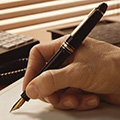
CEO of Onsen.com Co.,Ltd.
For more than 30 years, he has been visiting hot spring ryokans all over Japan, persuading innkeepers of the need for "private baths". He is still a traveler who spends half of the year at a hot spring. In addition to being a article creater, photographer, and drone pilot, he also designs websites and provides consulting services.
